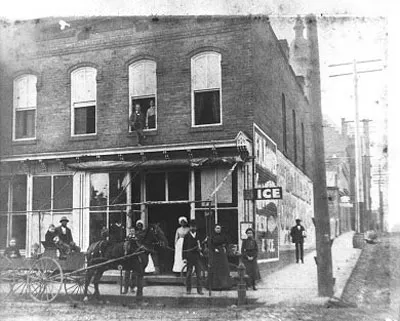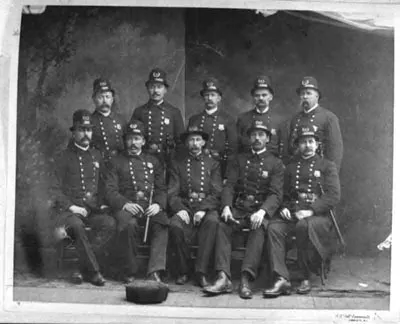They were supposed to be the good old days. A hundred years ago, we've all been told, there was no need to lock the doors, children didn't have to worry about "strangers" and violence was a rarity. But in the last few decades, the story goes, we abandoned our morals and society went to Hell.
Or did it?

- A typical corner store in Charlotte, circa the early 1900s.
These days, it's rare for a week to go by in Mecklenburg County without at least one murder, rape or stabbing making headlines, which means things are pretty much exactly as they were 100 years ago. In 1900, it also was rare for a week to go by without at least one rape, stabbing or murder making headlines. The only real difference between then and now is that there were only 55,000 people living in the county a century ago; there are about 830,000 living here today.
A review of thousands of court documents and several years worth of the Charlotte News (1899 to 1926), showed that Charlotte has a surprisingly violent, bloody past that most people probably aren't aware of.
No agency kept crime statistics back then, but anecdotal evidence shows that the roots of the culture of violence that Charlotte would develop later in the century can be traced to the early 1900s. During that period, racial tensions simmered as whites moved to lock blacks out of the political process and the rural poor began relocating to population centers in large numbers, bringing their desperate poverty with them. Many people worked on the county's 4,100 farms or in the mills, earning $15 to $20 a month, barely enough to survive on.
With so little to lose and tempers pushed to the limit by the realities of life, violence at the slightest provocation was common. Husbands shot wives dead in the streets and jealous boyfriends gunned down their sweethearts for walking home from church with another man. With a rifle costing an average of two months' salary, many desperate people were forced to make do with simpler weapons. People often used razors in assaults. Popular weapons of choice for bashing each other's brains out were rocks, axes, sticks and in one case, a large table fork. Violence with rocks was so common that two separate assault charges were developed for rock-based crimes -- one if the rock weighed more than three pounds and another if it weighed less.
Back then, people charged with crimes had their first court appearances before the mayor. It wasn't unusual for two people arrested on assault charges to appear before him the next day alongside folks who'd committed the most common lesser crimes of the day, such as larceny, gambling, vagrancy, selling whiskey and having sex outside marriage. The mayor had little incentive to dismiss crimes, because forced convict labor during that period built most of Charlotte's public infrastructure. Even the simplest crimes, like playing a card game for money or stealing an old pair of shoes, could earn an inmate a month or several months on a chain gang.
But there were ways around a stiff sentence. Justice in Charlotte 100 years ago was as much a popularity contest as it was a revenue generator. If reports of your crime in the newspaper won the public's sympathy, the mayor often dropped the charges against you. It wasn't unusual for the Charlotte News to report that someone had been let off on larceny charges because he was "good looking" and the will of the public was behind him. Of course, "good looking" was in the eye of the (white) beholder.
The legacy of that period of Charlotte's history was a rolling crime wave that would grip the city for more than six decades. By the early 1940s, Charlotte had the highest violent crime rate in the South. Twenty years later, according to FBI crime reports, Charlotte had the highest homicide rate of any city in the nation. Since then, it's gotten better and then worse again. But it's nowhere near as crazy as it was in 1900.
ROCK, SCISSORS, HAMMER, RAZOR: Sam Maxwell and Josie Covington were arrested in August of 1912 for fighting in public with deadly weapons. One used a razor, the other a hammer. They were both sentenced to 60 days in jail, during which time they were to be hired out to work by the county commission.
• Two months later, Allen Jackson was arrested for the same crime, but he only got 30 days in jail, during which time he was assigned to work the roads.
SCARLET LETTER: Law enforcement priorities were a bit different a century ago. Back then, merely shacking up could earn you a jail term. On May 1, 1902, Joe McClure and Maria Morrow were arrested and charged with cohabitation while not being married.

- The Charlotte police force, ca. late 1800s.
• Robert Stevenson and Maggie Stilwell, who were described in court documents as "lewd and lascivious persons," were arrested in January 1902 for adultery and fornication. Both cohabitation and the charge adultery and fornication seemed to be common during the period, and multiple examples appeared in the court records.